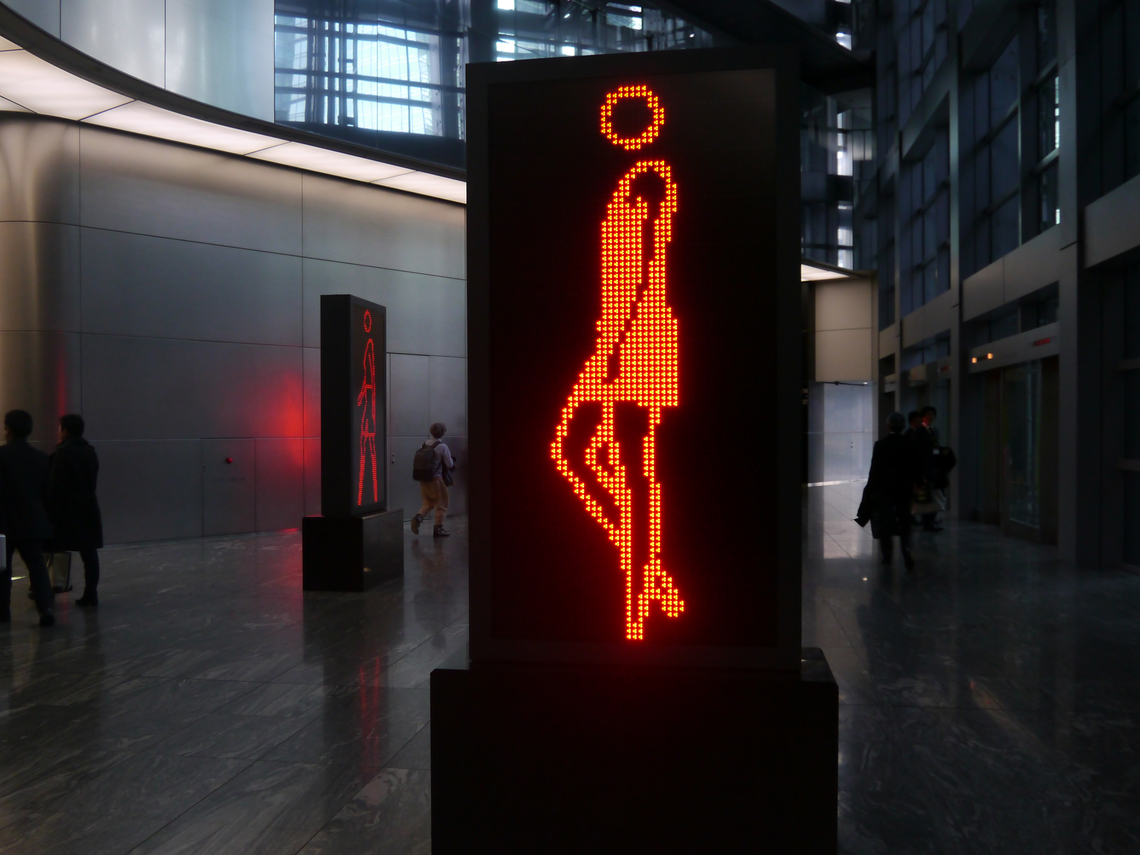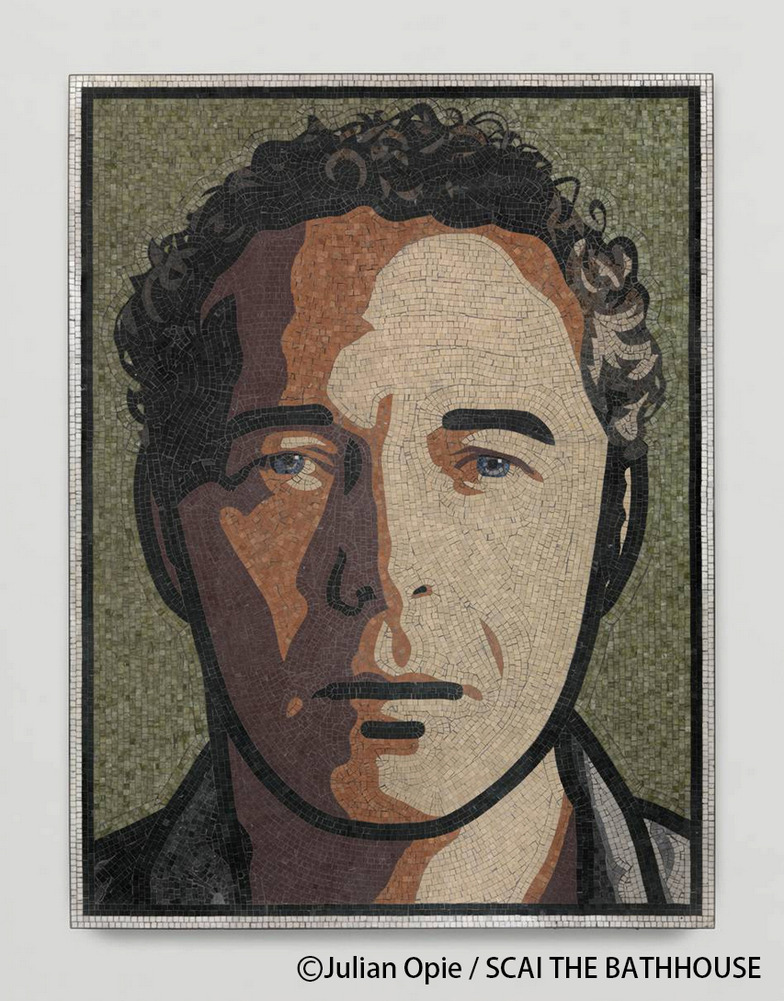Julian Opie: "Movement and simplicity come from Japanese art and pop culture."
I want to use LEDs to deliver unexpected works
Artists are often thought to have multiple options for expression and can create whatever work they like—for example, painting today and making a video work tomorrow. But that's not actually the case. Creating art is like walking down a dark hallway, straining your eyes. Occasionally, you find a door. Opening it reveals new possibilities, shifting the boundaries of your own domain. That's where new technology comes in—like LEDs. This element of "movement" plays a crucial role in my work. A piece at Dentsu Inc.'s headquarters in Shiodome, Tokyo, which uses LEDs to express the human form in walking in a very simple way, also has movement as its theme.
LEDs have now become like the language of the city. They are distinctive and popular, yet they also carry a slight sense of aversion. That's only natural. After all, LEDs are the "language of authority." If you see an LED sign saying "Stop," people stop. However, if it were written in chalk, most people would ignore it. If "Stop" were written in chalk on dusty pavement, people would likely walk right over it. But if it's written in LEDs, you think, "Oh, this is important." That's an interesting characteristic of LEDs. I like the combination of the form of these symbols, like signs and pictograms, with high-tech and poetic elements. Within that, I want to offer something different from what people usually expect.
When visiting a museum, you'd expect bronze statues, stone sculptures, oil paintings, and such. But for me, the real things in everyday life are far more interesting. Of course, museums have diversified recently, but tradition still lingers a bit. That's where I want to place things people don't expect, like works using LEDs. Then, instead of thinking about museums or art, viewers might recall ordinary things like school, cars, or commuting. Moreover, oil paintings and LEDs convey entirely different impressions even when depicting the same subject. Oil paintings inevitably evoke associations with museums and history. LEDs, on the other hand, make people think of cities or airports. This is why LEDs are such a uniquely personal medium for me.

The Beauty of Movement Learned from Hiroshige's Landscape Paintings
My work is often described as minimalist or simplified, but I actually start from the opposite perspective. It's not about simplifying something complex; rather, I gradually add the bare minimum necessary for expression, starting from nothing. For example, in the aforementioned work depicting a walking figure, I express it using only minimal elements like arms, legs, clothing, and movement. This characteristic of my work is actually influenced by Japanese art and anime.
I am drawn to art with a purpose and collect Japanese ukiyo-e prints. Woodblock prints, in particular, were less about being fine art pieces back then and more like postcards or travel guides. It was precisely because of the limitations in size, cost, and technique that they could be ingeniously crafted to produce such beautiful works. I draw inspiration from their subjects, composition, techniques, framing, and the very idea of simplifying the work.
Sometimes I create works aiming to evoke associations with these inspiring artworks. In 2007, I made a piece featuring a computer-embedded LCD screen displaying landscape paintings in the style of Utagawa Hiroshige. It was a video, based on photos I took while driving around Mount Fuji, showing ripples on the water, birds flying, and tree branches swaying in the wind. Hiroshige's works have movement, even though they're paintings, right? People in boats going down rivers, flying birds, his famous depictions of rain. The technology didn't exist in Hiroshige's time, but I, in the modern era, can add movement to that rain. Even if people don't know much about Hiroshige himself, many have seen his works, like the rain falling on a bridge. I want people to find the image of Hiroshige's prints in my work.
All art techniques are technology—LEDs, stone carving,
Not just ukiyo-e, but I've also collected hundreds of hand-drawn animation cels from Studio Ghibli's Hayao Miyazaki and Sailor Moon. They're incredibly beautiful. I've learned two main things from anime and manga. One is portraits with movement. Typically, portraits are static because the model consciously avoids moving. In manga, however, facial expressions and body language are integral to the story, so they're always in motion. I challenge myself to create portraits that capture a fleeting moment of action. The second is the use of shadow. The dramatic shading applied to faces in manga is incredibly instructive.
All art techniques are technology. Programming LEDs is technology; carving stone is technology. Japan has so many fascinating things. I'm particularly drawn to its carving techniques. I've also tried carving images into stone with Japanese artisans. Beyond that, I find traditional architecture, temples, old buildings, all kinds of signs and billboards, the calligraphy on them, things carved or painted on stone, neon signs, plastic objects, and even the look of city streets captivating. Every time I visit Japan, I take a huge number of photos and bring them back.
 "Self-Portrait" 2012
"Self-Portrait" 2012Julian Opie
Born 1958 in London, UK. Contemporary artist. Emerged as a rising star in the art scene during the 1980s with works characterized by humor and critical commentary. He has continued to incorporate new techniques, releasing series such as portraits, racing courses, and figurative works, gaining fans worldwide. Major museums globally now hold works by Opie.
Was this article helpful?